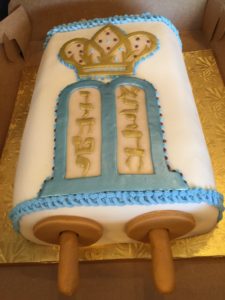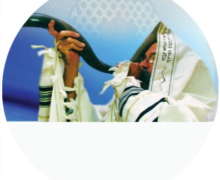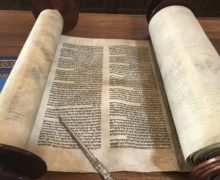Torah Scroll
(For more information about the making of a Torah Scroll, please refer to list at the bottom of this article)
Today, Congregation Faithful Stewardship is honored to have all of you here to dedicate its own Kosher Hebrew Torah Scroll.*
I would like to talk to you for a moment about “The meaning of the Torah Scroll” and why the Yeshua, the Apostles and Paul all read from the Torah Scroll as they attended Shabbat service, and why the Torah was the foundation of their faith.
Before I get started I would like to recognize Lori and Jim Robeson for buying our first Hebrew Torah Scroll as a gift to CFS with their own money… Thank you!
Our new Torah Scroll is 80 years old! This is exactly what CFS had been looking for. This Torah Scroll was written in Romania during a period when European anti-Semitism was on a rise; 80 years ago anti-Semitism in Romania was at a peak. In spite of the hatred toward Jews, a sofer (scribe) diligently hand wrote every letter on our Scroll. Even more astounding is that our Scroll passed through the Holocaust, giving it a personal history that needs to be acknowledged and revered. When we read from this Scroll, we are not only reading from God’s Holy Word but from a Torah Scroll with a note-worthy history!
Undoubtedly, many people were persecuted and murdered for protecting and preserving it.
During the Nazi reign of terror not only were literally millions of Jews were murdered but also thousands of Torah Scrolls were destroyed — few Scrolls survived. Ours is one which did! It is highly plausible to believe that people died and blood was shed that we might have this Scroll today.
When the Second World War came to a close, Israel brought many surviving scrolls to Israel for safe keeping. Ours was one. For the next 60 years, it served in a Tel Aviv synagogue.
Our Romanian Ashkenazic Torah Scroll made its second international trek a couple of weeks ago. This time from Israel to Tucson, AZ. Prior to its voyage, the Scroll was certified Kosher, which that every letter was present and clear – there were no mistakes; thereby, meeting all governing requirements of proper writing and assembling for a Kosher Torah Scroll.
Reading the Torah Scroll every seventh year: The Hakhel Ceremony
Deuteronomy 31:9-13:
Deut 31:9 So Moses wrote down this law and gave it to the Levitical priests, who carried the ark of the covenant of the LORD, and to all the elders of Israel.
וַיִּכְתֹּ֣ב מֹשֶׁה֮ אֶת־הַתֹּורָ֣ה הַזֹּאת֒ וַֽיִּתְּנָ֗הּ אֶל־הַכֹּהֲנִים֙ בְּנֵ֣י לֵוִ֔י הַנֹּ֣שְׂאִ֔ים אֶת־אֲרֹ֖ון בְּרִ֣ית יְהוָ֑ה
וְאֶל־כָּל־זִקְנֵ֖י יִשְׂרָאֵֽל׃
Deut 31:10 Then Moses commanded them: “At the end of every seven years, in the year for canceling debts, during the Festival of Tabernacles,
וַיְצַ֥ו מֹשֶׁ֖ה אֹותָ֣ם לֵאמֹ֑ר מִקֵּ֣ץ ׀ שֶׁ֣בַע שָׁנִ֗ים בְּמֹעֵ֛ד שְׁנַ֥ת הַשְּׁמִטָּ֖ה בְּחַ֥ג הַסֻּכֹּֽות׃
Deut 31:11 when all Israel comes to appear before the LORD your God at the place he will choose, you shall read this law before them in their hearing.
בְּבֹ֣וא כָל־יִשְׂרָאֵ֗ל לֵרָאֹות֙ אֶת־פְּנֵי֙ יְהוָ֣ה אֱלֹהֶ֔יךָ בַּמָּקֹ֖ום אֲשֶׁ֣ר יִבְחָ֑ר תִּקְרָ֞א אֶת־הַתֹּורָ֥ה הַזֹּ֛את נֶ֥גֶד
כָּל־יִשְׂרָאֵ֖ל בְּאָזְנֵיהֶֽם׃
Deut 31:12 Assemble the people–men, women and children, and the foreigners residing in your towns–so they can listen and learn to fear the LORD your God and follow carefully all the words of this law.
הַקְהֵ֣ל אֶת־הָעָ֗ם הָֽאֲנָשִׁ֤ים וְהַנָּשִׁים֙ וְהַטַּ֔ף וְגֵרְךָ֖ אֲשֶׁ֣ר בִּשְׁעָרֶ֑יךָ לְמַ֨עַן יִשְׁמְע֜וּ וּלְמַ֣עַן יִלְמְד֗וּ וְיָֽרְאוּ֙
אֶת־יְהוָ֣ה אֱלֹֽהֵיכֶ֔ם וְשָׁמְר֣וּ לַעֲשֹׂ֔ות אֶת־כָּל־דִּבְרֵ֖י הַתֹּורָ֥ה הַזֹּֽאת׃
Deut 31:13 Their children, who do not know this law, must hear it and learn to fear the LORD your God as long as you live in the land you are crossing the Jordan to possess.”
Ezra stood on a high wooden platform for the Reading
Nehemiah 8:1-6
Neh 8:1 all the people came together as one in the square before the Water Gate. They told Ezra the teacher of the Law to bring out the Book of the Law of Moses, which the LORD had commanded for Israel.
Neh 8:2 So on the first day of the seventh month Ezra the priest brought the Law before the assembly, which was made up of men and women and all who were able to understand.
Neh 8:3 He read it aloud from daybreak till noon as he faced the square before the Water Gate in the presence of the men, women and others who could understand. And all the people listened attentively to the Book of the Law.
Neh 8:4 Ezra the teacher of the Law stood on a high wooden platform built for the occasion. Beside him on his right stood Mattithiah, Shema, Anaiah, Uriah, Hilkiah and Maaseiah; and on his left were Pedaiah, Mishael, Malkijah, Hashum, Hashbaddanah, Zechariah and Meshullam.
Neh 8:5 Ezra opened the book. All the people could see him because he was standing above them; and as he opened it, the people all stood up.
Neh 8:6 Ezra praised the LORD, the great God; and all the people lifted their hands and responded, “Amen! Amen!” Then they bowed down and worshiped the LORD with their faces to the ground.
Apostolic Scriptures
Devote yourself to the public reading of Scripture (TaNaKh)
It should be noted that at the time these letters were in circulation to synagogues (congregations) they were not considered authoritative or to be equal with the Torah, Prophets, and Writings (TaNaKh). When the term Scriptures or public reading is mentioned in the letters (New Testament) it was a referencing the TaNaKh. The TaNaKh was and is the foundation of The Way. Yeshua, the Apostles and Paul and James never broke the TaNaKh, for it is the constitution of our faith in the Messiah. The Torah and Prophets was the unchallenged core of the Public Reading in services. This practice continued for the first 100 years until antisemitism of the gentiles started a separate church structure.
In 2 Timothy 3:15-20 Paul instructed Timothy how to Oversee and care for the church at Ephesus, Paul said that from infancy you have known the holy Scriptures (TaNaKh), which are able to make you wise for salvation through faith in Christ Jesus (in the Anointed One’s Salvation). All Scripture (TaNaKh) is God-breathed and is useful for teaching, rebuking, correction and training in righteousness, so that the man of God may be thoroughly equipped for every good work.
While on his way to Macedonia, Paul left Timothy in Ephesus to confront false teachers and to strengthen the body of believers. In a culture where people were turning away from Christ and were devoting themselves to deceitful spirits and teachings of demons, Paul commanded Timothy in this way: Until I come, devote yourself to the public reading of Scripture, to exhortation, to teaching (1 Timothy 4:13).
All of the synagogues had a raised platform, known as the Bema; it was from the Bema where the Torah was read, and was followed by a portion of the Prophets. The Gospel of Luke 4:15-20 it says that He taught in their synagogues… He went to Nazareth, where he had been brought up, and on the Sabbath day he went in the synagogue, as was His custom. The Torah reading was completed and it was time for the reading of the Prophets. And He (Yeshua) stood up to read. The scroll of the Prophet Isaiah was handed to Him. Unrolling it, He found the place where it is written: The Spirit of the LORD is on me… (Isa 61:1,2). Then He rolled up the scroll, gave it back to the attendant (Chazzan) and sat down.
James the brother of Yeshua stated: For Moses has been preached (TaNaKh) in every city from the earliest times and is read in synagogues on every Shabbat (Acts 15:21).
*For a better understanding of what a Kosher Hebrew Torah Scroll is and how it is made, go to
TO LEARN MORE (click on the links below):



